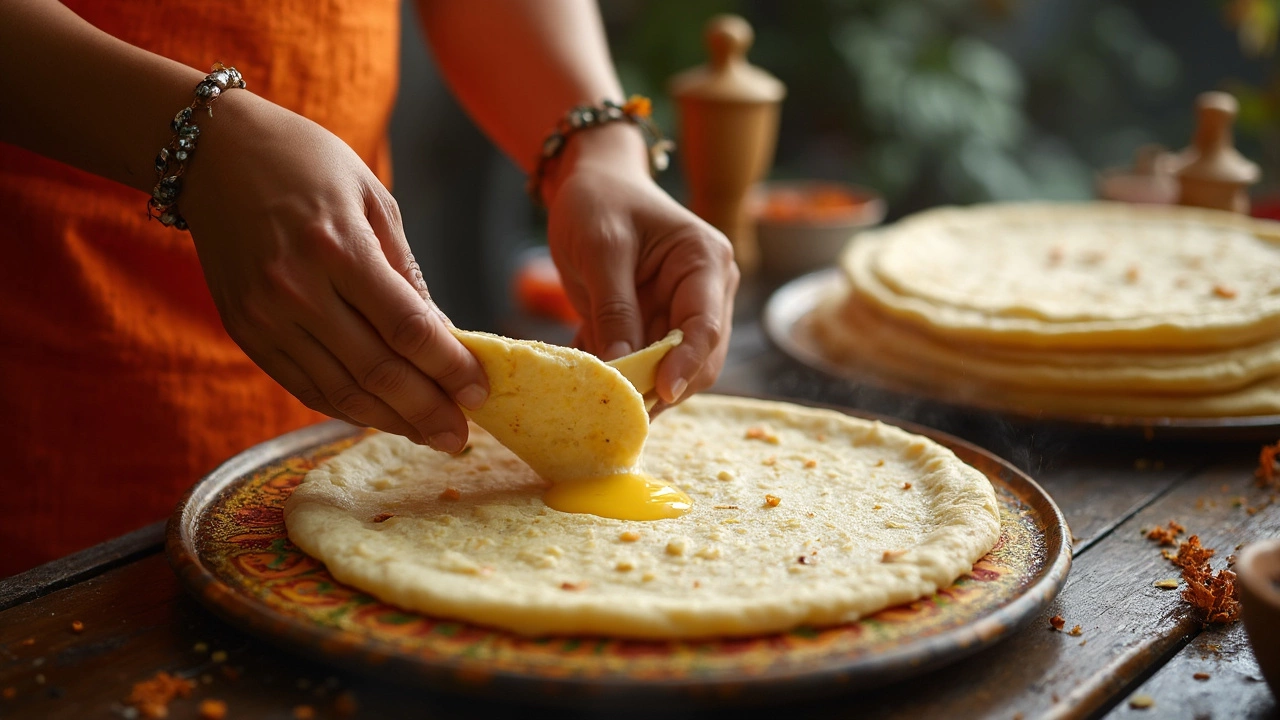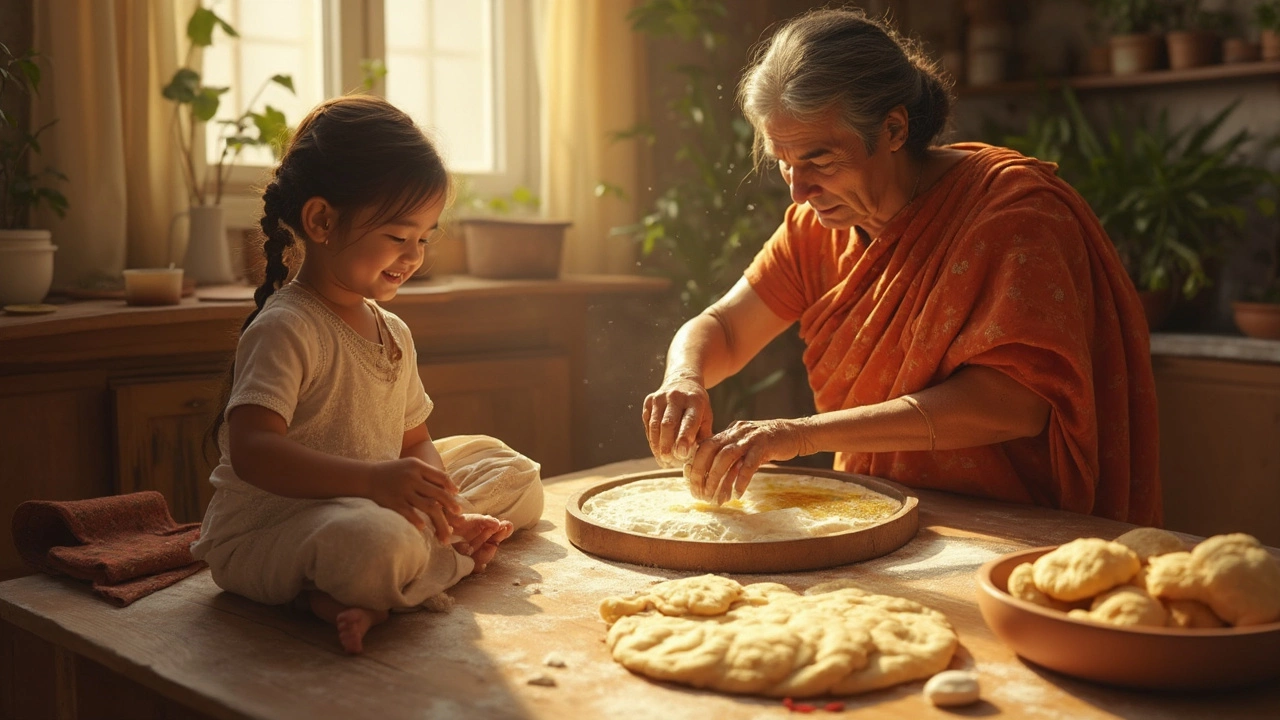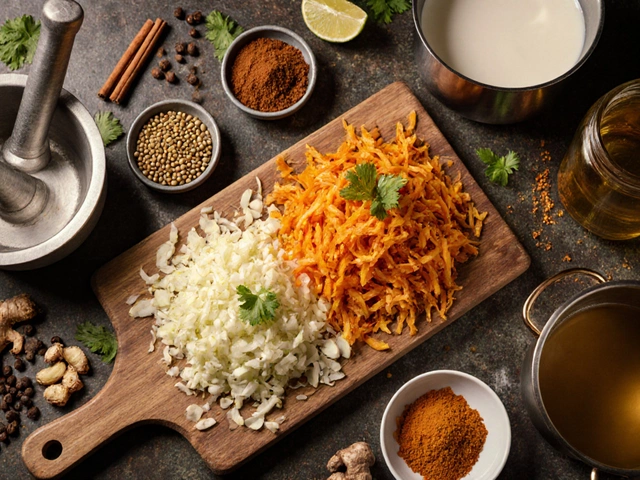Struggling with tough, chewy rotis that don't quite hit the mark? You're not alone. Tons of home cooks wonder if a dash of oil can really make a difference. The answer: Yes, oil can totally change your roti game. But it's not just about dumping a bunch of oil into your dough. There's a bit of know-how involved.
Here's the deal—oil works by coating the flour particles, stopping too much gluten from forming. More gluten means tougher rotis. Add a little oil and your rotis stay softer, even if you reheat them later. This is why a lot of families pass down that “one spoon of oil” rule.
Think about those days when your roti tears or cracks as you roll it out. That usually means your dough's too dry or overworked. Oil helps stop all that drama. Just a tiny amount, right at the mixing stage, goes a long way. And if you're using whole wheat flour, oil is even more important since this kind of flour tends to soak up water and get heavy pretty fast.
- Why Do Some Rotis Turn Out Hard?
- The Science Behind Oil’s Magic in Dough
- How Much Oil Should You Use—and When?
- Common Mistakes to Avoid with Oiled Rotis
Why Do Some Rotis Turn Out Hard?
Tough or hard rotis are usually a sign that something’s off in the dough or cooking process. The main culprit? Gluten. When you mix flour and water, gluten forms and gives dough its stretch. Too much gluten or not enough moisture makes rotis hard and chewy.
Another common reason is not enough water while kneading. Dry dough doesn’t puff up well and leads to stiff rotis. Also, if you knead the dough for too long, gluten gets extra strong, which means less softness.
Check out these usual suspects behind hard rotis:
- You didn’t use enough water or used cold water instead of warm.
- You skipped the resting step, so your dough didn’t relax.
- Roti was cooked too long or on low heat, drying it out.
- Rolling the roti too thick or too thin—both cause texture issues.
- Not adding any fat (like oil in roti).
Here’s a quick look at a few factors and how they affect roti texture:
| Factor | Result |
|---|---|
| Dry Dough | Tough, doesn’t puff up |
| Over-kneading | Rubbery texture |
| Not Enough Fat | Chewy, hard rotis |
| Under-resting the Dough | No softness, cracks appear |
| Incorrect Cooking Temp | Dry, stiff rotis |
So, it's not just your recipe—small changes like using enough water, resting dough, and adding a touch of oil can be game-changers. If your rotis aren’t soft, these details could be what’s holding you back.
The Science Behind Oil’s Magic in Dough
So how does oil actually make your rotis softer? It’s all about how the flour, water, and oil mix together. When you knead flour and water alone, the gluten proteins stretch, link up, and form a web. This web traps steam and gives structure, but too much of it makes the roti chewy or stiff, which isn’t the soft roti we want.
Add a bit of oil into the mix and it coats the flour, kind of like putting a raincoat on each grain. This stops those gluten chains from tightening up too much. The end result: a roti that’s flexible, tender, and can even stay soft for hours after cooking.
Many home cooks add about one teaspoon of oil for every cup of wheat flour. That tiny change is enough to notice a difference. Store-bought rotis or ready-made parathas use this trick all the time mixed right into their dough to keep things soft and easy to pack.
- Oil makes the dough easier to mix, reducing hand fatigue.
- It helps with rolling—no more cracks around the edges.
- Cooked rotis puff up nicer, since the reduced gluten network doesn’t trap steam in tight pockets.
- Leftovers don’t dry out nearly as fast.
If you want to see just how much oil changes things, look at this quick table comparing rotis with and without oil, based on what home cooks often notice:
| Feature | Roti Without Oil | Roti With Oil |
|---|---|---|
| Texture | Chewy, sometimes dry | Softer, moist |
| Rolling | Tears/cracks easily | Stays smooth |
| Storage | Hardens quickly | Stays soft longer |
| Cooking Puff | Inconsistent | Even, puffy rotis |
So next time you’re aiming for that soft roti feel, reach for a little cooking oil. Your dough—and your taste buds—will thank you.

How Much Oil Should You Use—and When?
Getting the right amount of oil makes all the difference between a soft, fluffy roti and one that chews like cardboard. You really don’t need much—just the right timing and the right dose. For every cup of whole wheat flour, start with about one teaspoon of oil. That’s not much, but it’s enough to make the dough smoother and the final roti softer.
The golden rule is to add oil right as you mix the flour and water. Don’t wait until the dough is fully formed. Mixing it in at the start lets the oil coat the flour right away, blocking some of that tight gluten network that makes roti turn rubbery. After kneading, you can also lightly coat the dough ball with a few drops of oil and rest it for 10–15 minutes. This step “locks in” moisture and helps soften things even more.
But hey, don’t go overboard. Too much oil will mess with the texture, making rotis feel greasy, heavy, and impossible to puff up. Stick to the ratio below:
| Flour (cups) | Recommended Oil (teaspoons) |
|---|---|
| 1 | 1 |
| 2 | 2 |
| 4 | 4 (or a bit less if you want a lighter bite) |
Some people like to brush a thin layer of oil on each roti just after it comes off the pan. This keeps moisture in for longer and gives you extra softness—especially handy if you plan to stack and store them for later.
If you’re all about oil in roti, just remember: start small, stick to the ratios, and add oil at the right moment during mixing. That’s the real secret behind those cloud-soft rotis.
Common Mistakes to Avoid with Oiled Rotis
It's easy to assume more oil equals softer roti, but that's just not true. Getting the perfect soft roti is all about balance and timing. Here are the most common mistakes that catch people off-guard—and how to avoid them.
- Too much oil: Some folks think drowning the dough in oil will make the roti fluffier. Honestly, excess oil leads to greasy, dense rotis that don't puff up. Stick to one teaspoon per cup of flour. If you go wild with oil, rotis turn heavy and lose that classic, light bite.
- Adding oil too late: Oil needs to go in when you start mixing the dough, not after it’s already come together. If you add it halfway, the flour won’t absorb it right, and you'll end up with uneven texture. Throw it in at the start so everything blends perfectly.
- Ignoring water balance: It’s pretty common to forget that oil changes how much water your dough needs. Dough that’s got oil will need just a touch less water. If you follow your usual recipe without thinking about this, you’ll get sticky, hard-to-roll dough. Go slow, and adjust the water bit by bit.
- Using cold oil: This may sound picky, but using chilled or straight-from-the-fridge oil can make the mixing process weirdly difficult, especially in the winter. You want oil at room temperature so it spreads evenly.
- Rolling too thin or too thick: If you’ve added oil, be careful when rolling. If it’s too thin, the roti gets crisp instead of soft. Too thick, and it stays doughy inside. Aim for even thickness, usually about 2mm.
| Mistake | Result | Quick Fix |
|---|---|---|
| Extra oil | Greasy, heavy rotis | Stick to one teaspoon per cup of flour |
| Add oil late | Uneven texture | Mix oil in with flour first |
| Too much water | Sticky dough | Add water slowly, adjust as needed |
| Cold oil | Lumpy, uneven dough | Use room temp oil |
| Uneven rolling | Parts hard, parts undercooked | Roll to even thickness |
The most important thing: trust your hands, not just the recipe. Feel the dough. If it’s soft but not sticky, you’re on the right track with your oil in roti technique.
- Poplular Tags
- oil in roti
- soft roti tips
- roti making
- roti dough
- cooking roti











